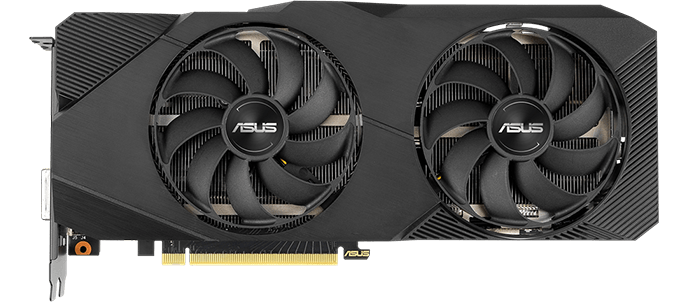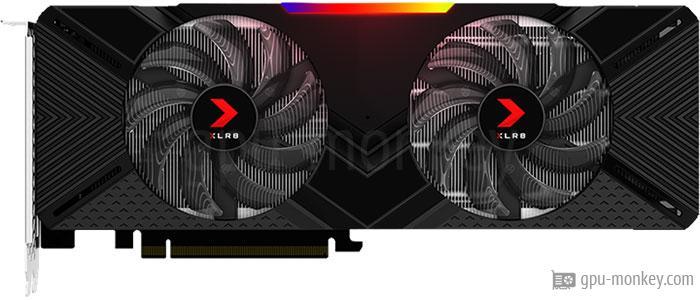
ASUS Dual GeForce RTX 2070 Evo Advanced
vs
PNY GeForce RTX 2080 XLR8 Gaming
GPU comparison with benchmarksThe ASUS Dual GeForce RTX 2070 Evo Advanced has 2304 shader units and these clock a maximum of 1.66 GHz which results in an FP32 computing power of 7.62 TFLOPS.
The PNY GeForce RTX 2080 XLR8 Gaming has 2944 shader units and these clock at a maximum of 1.75 GHz and achieve an FP32 computing power of 10.31 TFLOPS. |
||
GPUThe ASUS Dual GeForce RTX 2070 Evo Advanced is equipped with a graphics chip of the Turing architecture, which has 36 streaming multiprocessors. The graphics card PNY GeForce RTX 2080 XLR8 Gaming is based on the Turing architecture and is equipped with 46 execution units. |
||
| ASUS Dual GeForce RTX 2070 Evo Advanced | GPU | PNY GeForce RTX 2080 XLR8 Gaming |
| NVIDIA GeForce RTX 2070 | Based on | NVIDIA GeForce RTX 2080 |
| TU106 | GPU Chip | TU104 |
| Turing | Architecture | Turing |
| 36 | Streaming Multiprocessors | 46 |
| 2304 | Shader | 2944 |
| 64 | Render Output Units | 64 |
| 144 | Texture Units | 184 |
| 36 | Raytracing Cores | 46 |
MemoryThe ASUS Dual GeForce RTX 2070 Evo Advanced is equipped with a 8 GB large GDDR6 graphics memory, which is equipped with 1.750 GHz clocks. The PNY GeForce RTX 2080 XLR8 Gaming has a 8 GB large GDDR6 graphics memory and the memory clock is 1.750GHz. |
||
| 8 GB | Memory Size | 8 GB |
| GDDR6 | Memory Type | GDDR6 |
| 1.750 GHz | Memory Clock | 1.750 GHz |
| 14.0 Gbps | Memory Speed | 14.0 Gbps |
| 448 GB/s | Memory bandwidth | 448 GB/s |
| 256 bit | Memory Interface | 256 bit |
Clock SpeedsThe ASUS Dual GeForce RTX 2070 Evo Advanced has a turbo clock of 1.655 GHz. The turbo frequency of the PNY GeForce RTX 2080 XLR8 Gaming is 1.750 GHz. |
||
| 1.410 GHz | Base Clock | 1.515 GHz |
| 1.655 GHz | Boost Clock | 1.750 GHz |
| 1.64 GHz | Avg (Game) Clock | 1.71 GHz |
| Yes | Overclocking | Yes |
Thermal DesignThe ASUS Dual GeForce RTX 2070 Evo Advanced has 1 x 8-Pin connectors through which it is supplied with power. The manufacturer specifies the maximum operating temperature of the graphics card as 89 °C. The PNY GeForce RTX 2080 XLR8 Gaming is equipped with a 1 x 6-Pin, 1 x 8-Pin PCIe power connector that supplies it with power. The maximum operating temperature of the card is 88 °C. |
||
| 175 W | TDP | 215 W |
| -- | TDP (up) | -- |
| 89 °C | Tjunction max | 88 °C |
| 1 x 8-Pin | PCIe-Power | 1 x 6-Pin, 1 x 8-Pin |
Cooler & FansThe graphics processor and graphics memory of the ASUS Dual GeForce RTX 2070 Evo Advanced are cooled with a Air cooling. The PNY GeForce RTX 2080 XLR8 Gaming is cooled by a Air cooling. |
||
| Axial | Fan-Type | Axial |
| 2 x 90 mm | Fan 1 | 2 x 90 mm |
| -- | Fan 2 | -- |
| Air cooling | Cooler-Type | Air cooling |
| 0 dB | Noise (Idle) | dB |
| -- | Noise (Load) | -- |
ConnectivityThe ASUS Dual GeForce RTX 2070 Evo Advanced supports the downward compatible copy protection HDCP in version 2.2. The PNY GeForce RTX 2080 XLR8 Gaming supports HDCP in version 2.2 and all previous versions. |
||
| 4 | Max. Displays | 4 |
| 2.2 | HDCP-Version | 2.2 |
| 2x HDMI v2.0b | HDMI Ports | 1x HDMI v2.0b |
| 2x DP v1.4a | DP Ports | 3x DP v1.4a |
| 1 | DVI Ports | -- |
| -- | VGA Ports | -- |
| -- | USB-C Ports | 1 |
FeaturesetThe ASUS Dual GeForce RTX 2070 Evo Advanced supports the DirectX standard from Microsoft in version 12_2 (Ultimate). The PNY GeForce RTX 2080 XLR8 Gaming supports Microsoft's DirectX version 12_2 (Ultimate). |
||
| 7680x4320 | Max. resolution | 7680x4320 |
| 12_2 (Ultimate) | DirectX | 12_2 (Ultimate) |
| Yes | Raytracing | Yes |
| Yes | DLSS / FSR | Yes |
| No LED lighting | LED | Addressable LED |
Supported Video CodecsThis area lists which video codecs can be decoded or encoded by the graphics cards in hardware. As a result, the power consumption can be reduced due to a lower processor load. |
||
| Decode / Encode | h264 | Decode / Encode |
| Decode / Encode | h265 / HEVC | Decode / Encode |
| No | AV1 | No |
| Decode | VP8 | Decode |
| Decode | VP9 | Decode |
DimensionsThe ASUS Dual GeForce RTX 2070 Evo Advanced is -- wide and therefore needs the space of 2 PCIe-Slots in the case. The width of the PNY GeForce RTX 2080 XLR8 Gaming is -- and thus requires the space of 2 PCIe-Slots in the PC case. |
||
| 267 mm | Length | 292 mm |
| 118 mm | Height | 114 mm |
| -- | Width | 35 mm |
| 3 PCIe-Slots | Width (Slots) | 2 PCIe-Slots |
| -- | Weight | -- |
| PCIe 3.0 x 16 | GPU Interface | PCIe 3.0 x 16 |
Additional dataManufactured using the 12 nanometer process, ASUS Dual GeForce RTX 2070 Evo Advanced was released in Q3/2019. The PNY GeForce RTX 2080 XLR8 Gaming published in Q3/2018 is manufactured with a structure width of 12 nanometers. |
||
| DUAL-RTX2070-A8G-EVO | Part-no | VCG20808DFPPB |
| Q3/2019 | Release date | Q3/2018 |
| 499 $ (Reference) | Launch Price | 699 $ (Reference) |
| 12 nm | Structure size | 12 nm |
| data sheet | Documents | -- |
Rate these graphics cards now
Benchmark results
3DMark Benchmark (DirectX, Raytracing)
3DMark is a benchmark program that determines the performance of certain components of a computer and then reports the performance as a numerical value.
Time Spy Extreme Graphics score

|
ASUS Dual GeForce RTX 2070 Evo Advanced
8 GB GDDR6 |
||

|
PNY GeForce RTX 2080 XLR8 Gaming
8 GB GDDR6 |
||
Port Royal (Raytracing)

|
ASUS Dual GeForce RTX 2070 Evo Advanced
8 GB GDDR6 |
||

|
PNY GeForce RTX 2080 XLR8 Gaming
8 GB GDDR6 |
||
Speed Way Graphics Score (Raytracing)

|
ASUS Dual GeForce RTX 2070 Evo Advanced
8 GB GDDR6 |
||

|
PNY GeForce RTX 2080 XLR8 Gaming
8 GB GDDR6 |
||
Cyberpunk 2077
Cyberpunk 2077 was developed by CD Projekt Red and is based on the development studio's own REDengine 4. Ray tracing is switched off in our benchmarks.
3840x2160 (2160p)

|
ASUS Dual GeForce RTX 2070 Evo Advanced
8 GB GDDR6 |
||

|
PNY GeForce RTX 2080 XLR8 Gaming
8 GB GDDR6 |
||
2560x1440 (1440p)

|
ASUS Dual GeForce RTX 2070 Evo Advanced
8 GB GDDR6 |
||

|
PNY GeForce RTX 2080 XLR8 Gaming
8 GB GDDR6 |
||
1920x1080 (1080p)

|
ASUS Dual GeForce RTX 2070 Evo Advanced
8 GB GDDR6 |
||

|
PNY GeForce RTX 2080 XLR8 Gaming
8 GB GDDR6 |
||
Battlefield 5
Battlefield 5 is a visually stunning game that is ideal as a graphics card benchmark. We test the game with maximum details on Windows 10.
3840x2160 (2160p)

|
ASUS Dual GeForce RTX 2070 Evo Advanced
8 GB GDDR6 |
||

|
PNY GeForce RTX 2080 XLR8 Gaming
8 GB GDDR6 |
||
2560x1440 (1440p)

|
ASUS Dual GeForce RTX 2070 Evo Advanced
8 GB GDDR6 |
||

|
PNY GeForce RTX 2080 XLR8 Gaming
8 GB GDDR6 |
||
1920x1080 (1080p)

|
ASUS Dual GeForce RTX 2070 Evo Advanced
8 GB GDDR6 |
||

|
PNY GeForce RTX 2080 XLR8 Gaming
8 GB GDDR6 |
||
Geekbench 6 (OpenCL, Vulkan, Metal)
Geekbench 6 is a cross-platform benchmark for main processors, which also carries out 3 different graphics benchmarks and outputs them in the form of a numerical value.
Geekbench 6 - OpenCL

|
ASUS Dual GeForce RTX 2070 Evo Advanced
8 GB GDDR6 |
||

|
PNY GeForce RTX 2080 XLR8 Gaming
8 GB GDDR6 |
||
Geekbench 6 - Vulkan

|
ASUS Dual GeForce RTX 2070 Evo Advanced
8 GB GDDR6 |
||

|
PNY GeForce RTX 2080 XLR8 Gaming
8 GB GDDR6 |
||
FP32 Performance (Single-precision TFLOPS)
The theoretical computing power of the graphics card with single precision (32 bit) in TFLOPS indicates how many trillion FP32 floating point operations the graphics card (GPU) can perform per second.
FP32 (TFLOPS)

|
ASUS Dual GeForce RTX 2070 Evo Advanced
8 GB GDDR6 |
||

|
PNY GeForce RTX 2080 XLR8 Gaming
8 GB GDDR6 |
||
Popular comparisons











